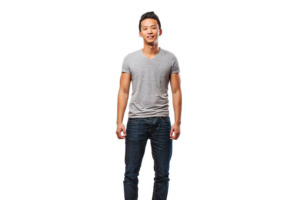In our digital world, it’s no wonder images have the power to attract or repel potential customers. But, how do you choose the right image to intrigue your audience and inspire them to action?
Choosing the best images for your campaign can make the difference between success and failure. Your ad — no matter where it appears — is your effort to gain the attention of passers-by and teach them something about your brand. The right image is critical to what they’ll learn and how they’ll respond.
Images impact us on a primal level.
Images are proven to boost online engagement, whether they’re for ads or news articles or Facebook posts. Our eyes guide us every day, and while it may sound primal, sight is one of the key senses that alerts us to whether something is appealing and whether we should investigate further. Digital natives, or the generations who have been born into a world rife with technology, are highly visual, absorbing more information more quickly from images than from words. As the long-ago saying goes: “A picture is worth a thousand words.”
That means a very large segment of society learns by viewing an image that conveys a story — from problem to solution. If you show people the impact or end result of your product or service using the right image, you can communicate instantly why a person needs to click now and learn more.

For good or for bad, people value images over descriptions, ratings, reviews, and the depth of information provided. A great image will do much more than a lot of well-crafted words because it engages people on a different, faster, and more primal level.
Decide on your message first.
A common mistake marketers may make is to begin with an image they find appealing. That’s the reverse of how to set up your ad for success. Your first step is to decide on the message you want to convey in your ad. What do you want to tell people? What do you want people to know or do?
Once you’ve decided on your message, ask what types of images convey your message. Take all aspects of an image into account. For instance, colors are symbolic and can add to the unconscious message viewers receive. Supercolor.com notes that the color blue “represents both the sky and the sea and is associated with open spaces, freedom, intuition, imagination, inspiration, and sensitivity.” What effect would an orange color palette have? Or green?

Additionally, will your image focus on people’s faces or abstract images? What will the mood of the image be? What will the tone be? Everything about an image is at play when it comes to the message you want to send and the message your audience will receive.
What makes an image ‘right’?
The perfect or right image will elicit an emotional response from the person seeing your ad. Here is an excellent example of an image that won’t work in a particular context, such as an ad for a funeral parlor.

“An advert for a funeral parlor would be in bad taste if the figure in it looks happy, because the text is always about how wounds can be healed by a ‘caring’ organization willing to provide services for a fee.” – Mushowe Knowledge
As you can see from this not-so-great image example, the image must elicit a connection response from the viewer — a response that matches the product or service you are advertising.
Secondly, the image needs to connect with an individual state the reader connects with. So if your ad is highlighting a workshop on grief, the image needs to connect with the suffering a person is feeling.

The right image connects with your brand, creates an emotional connection with viewers, depicts a state they can see themselves in, and makes them want to find out more. If you’ve captured all this in the image, then it’s the right image.
Image size matters.
When choosing an image to use for your ad, it is essential to think about the format required for the platform you are advertising on. Using the many different social media platforms such as Instagram, Facebook, LinkedIn, and Twitter, you’ll notice their feeds do not use the same-size images.

This makes a difference when choosing an image. For example, if the dimensions of an ad image are square, you don’t want to cut off part of a person if that part, like the shoes, is an integral part of the message you want to portray. Your image size should never be a distraction from your message. Don’t use a landscape image if you are working on an ad for a platform that requires a square dimension; the image will lose its punch and break the connection you seek.

Download this valuable cheat sheet from Mailchimp to help choose the right ad image every time. It details the dimensions of the images based on the platform, giving you a base to work with.
Consider animation and video.
Video, GIFs, and animation are a big part of today’s digital ad space. YouTube is an enormous platform well worth investing your time and energy in learning about because people love to watch videos and you can get higher engagement levels through them.
If your image is powerful and provides the emotional connection you want, consider adding animations to the picture. Even a small amount of movement on a graphic will draw viewer attention to it. Here’s a great article to investigate if you want to learn more about using GIFs in your marketing.
When you take that first bite of DiGiorno Pizza… #RiseToTheOccasion pic.twitter.com/HyVomIGDly
— DiGiorno (@DiGiorno) April 7, 2016
So, what’s the right image?
In a nutshell, the right image:
- Conveys the message you want your viewers to understand.
- Connects emotionally with viewers through a shared experience or level of understanding.
- Creates an emotional reaction in viewers.
- Engages viewers to take action.
- Is developed for the platform it’s being used on.
- Uses color to enhance the emotional connection.
- Potentially uses animation or video to catch the viewers’ attention.
You’ll find your potential customers connect and engage more with your campaign efforts when you take the time to carefully vet your images.
